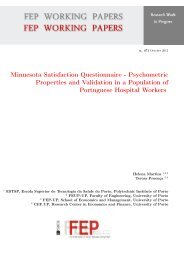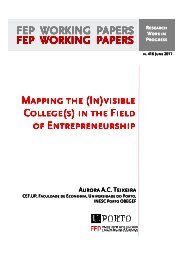FEP - Working Papers - Universidade do Porto
FEP - Working Papers - Universidade do Porto
FEP - Working Papers - Universidade do Porto
Create successful ePaper yourself
Turn your PDF publications into a flip-book with our unique Google optimized e-Paper software.
purchases at a single place. It is easy to verify that �<br />
i∈I |piL − piR| ≤ t implies that<br />
0 ≤ ˜x ≤ 1. Therefore, in this case, the demand for any good sold at L is ˜x and the demand<br />
for any good sold at R is 1 − ˜x.<br />
It is convenient to denote the vector of prices of all the goods at both locations by<br />
p ∈ IR 2n<br />
+ and to consider the following sets:<br />
S1 = � p ∈ IR2n + : �<br />
i∈I |piL − piR| ≤ t � ;<br />
S2 = � p ∈ IR2n + : �<br />
i∈I |piL − piR| > t � .<br />
If there are consumers that travel to both extremes, the demand for a good depends on<br />
whether this good is cheaper at L or at R. Denoting by IL and IR the sets of goods<br />
that are strictly cheaper at L and R, respectively, we can write the expressions for the<br />
indifferent consumers as follows:<br />
and<br />
˜xL = 1 − 1<br />
t<br />
˜xR = 1<br />
t<br />
�<br />
(piL − piR) (4)<br />
i∈IR<br />
�<br />
(piR − piL) . (5)<br />
i∈IL<br />
The demand for a good i ∈ IL at L is min {˜xR, 1}, while its demand at R is max {0, 1 − ˜xR}.<br />
If i ∈ IR, its demand at L is max {0, ˜xL} and its demand at R is min {1 − ˜xL, 1}. In case<br />
of a tie (piL = piR), each consumer that travels to both extremes may either buy good i<br />
at L or at R. Any tie-breaking assumption leads to the same results. We can assume, for<br />
example, that half of the consumers buys good i at L and the other half buys it at R.<br />
We find that the demand for good i at x = 0 is:<br />
qiL =<br />
⎧<br />
⎪⎨<br />
⎪⎩<br />
˜x if p ∈ S1<br />
min {˜xR, 1} if p ∈ S2 ∧ piL < piR<br />
1<br />
2 (min {˜xR, 1} + max {0, ˜xL}) if p ∈ S2 ∧ piL = piR<br />
max {0, ˜xL} if p ∈ S2 ∧ piL > piR<br />
while the demand for the same good at x = 1 is qiR = 1 − qiL.<br />
Without loss of generality, the marginal cost of producing one unit of each of the goods<br />
9<br />
,











